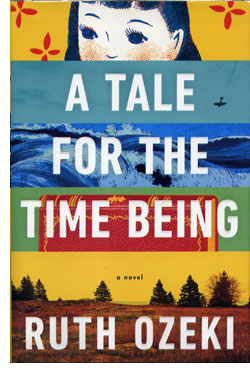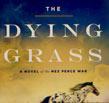 |
 |

Ruth Ozeki
A Tale for the Time Being
Reviewed by: Rick Kleffel © 2013
Viking Adult / Penguin Putnam
US Hardcover First Edition
ISBN 978-0-670-02663-0
Publication Date: 03-12-2013
422 Pages; $28.95
Date Reviewed: 04-06-2013
Index:
General Fiction
Science Fiction
Fantasy
The book is a solid object, a physical creation that you can hold in your hands. But it's also a mirage, something that appears real but is not, at least not until you begin reading, and it is only while you are read that the book assumes its true form. The voices you create as you scan the words are as ephemeral as thought itself, yet they can create memories that are analogous to actual experience. You spend actual time of your life reading, but within the book, you are a different being.
In 'A Tale for the Time Being,' Ruth Ozeki gives you the voice of Nao (now), that is, Naoko Yasutani, who is sitting in Electricity Town writing in her diary. Ruth, who lives on a remote island off the coast of Canada, is reading the diary, and you are reading her story. As the voices layer and echo, as the story curls in on itself and sets up shop in your life, as you create the story by reading the pages in this book, every page you turn, every word you read, is a choice that changes everything that follows. You have become The Time Being.
Ozeki's novel is compelling and cleaver, funny and harrowing, insightful and witty, wildly imaginative and inventive yet down to earth and occasionally quite gritty. 'A Tale for the Time' is a stealth novel, and it plants seeds that grow into unexpected hybrids. As Ruth in the novel reads Nao's diary, she becomes increasingly concerned for Nao's fate. Did Nao survive the tsunami? What of her aged grandmother or her suicidal father?
Nao's story is compelling stuff, but 'A Tale for the Time Being' has a contemplative pace that encourages readers to take their time. Here's a novel that actually knows you will find yourself not wanting it to end and guides you to read it in an appropriate manner. That in itself is a remarkable achievement, one of many to be found in both the physical object and the ineffable reading experience you can extract fro that stack of marked pages.
There are essentially two stories here, that of Nao and her family and that of Ruth and her family, that is, Ruth and her husband Oliver, who hear a remarkable similarity to the author and her husband. No matter whose voice you are reading, the worlds that Ozeki creates are utterly enchanting and the voices mesmerizing. 'A Tale for the Time Being' creates many worlds within its pages; Nao's life in California, in Japan, her grandmother's time in Taisho Japan, Ruth's world on a rural island, Nao's father's life, and more. The novel feels like an elaborately carved fresco, with stories in stories, documents, footnotes, appendices and search engine results. It's all very fun to read.
The stories you'll create as you read the novel are funny, poignant and sometimes disturbing. We live in a bullying world, where arrogant leaders push around those whose interests they are supposed to serve, and where young schoolgirls in Japan torment one another with an equal ferocity. But there is beauty and creativity as well, the sweet love and sacrifice of family. Ozeki's vision is balanced, embracing opposing visions with the ease of Nao's Buddhist monk grandmother.
But getting at the essence of lives in world where the future and past co-exist but do not mingle requires more than two simple stories, even if they are intertwined with the skill that Ozeki brings to the architecture of her novel. The imaginative leaps Ozeki makes in terms of storytelling are ultimately matched by her visions of the technology we use every day. Not surprisingly, her technological innovations end up as storytelling tools, turning 'A Tale for the Time Being' into a sort of kaleidoscope of shifting realities.
Ultimately, 'A Tale for the Time Being' ends up being the sort of book that can only be a book. Story exists outside of the means by which it may be told, and it is often easily ported from one form to another. But books require the active participation of the reader in order for the story to unfold. As you turn to the first page of 'A Tale for the Time Being,' you'll being to change, and that change will not be complete, even when you've finished reading the novel.
|
 |
|
|
 |
| |
Review Archive
All Reviews alphabetized by author.
General Fiction
Non-Genre, general fiction and literature.
Horror
Supernatural fiction, supernatural horror and non-supernatural horror.
Science Fiction
Science fiction, science fantasy, speculative fiction, alternate history.
Fantasy
Fantasy, surrealism and magic realism.
Mystery
Crime, thrillers, mystery, suspense.
Non-Fiction
Non-Fiction, True Crime, Forteana, Reference.
Poetry
|
|
 |
|




